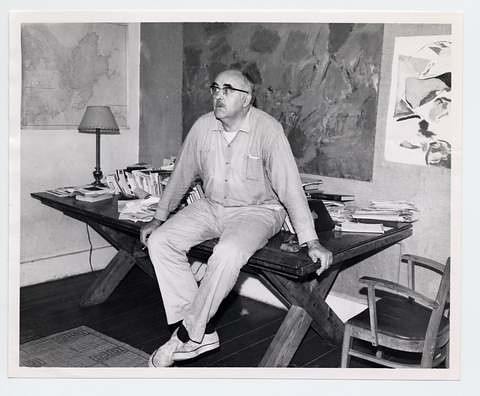New poetry & poetics blogs are coming along these days at a pretty steady clip. But perhaps the most interesting recent addition to the blogroll on the left belongs to none other than Charles Olson, dead now just about 35 years, but nearly as hard to keep in the grave as he was difficult to control during his relatively brief six decades among us. At
The blog itself is just the start of something, or so I hope, for if ever there was a poet whose spirit foretold the bricolage process that is the internet, it is Olson. I hope that Michael & Ammiel continue the process of adding both the personal reminiscences that are on the site now, as well as the materials that are building up as a “documents archive” for the event at the EPC website. Just as the Olson Society has become a clearing house for a retrospective project, OlsonNow could as easily become a literally projective project, taking the work forward into the contemporary moment & beyond.
One of the very best aspects of the materials gathered for OlsonNow is their diversity. Olson is not, by any means, a Rorschach, or available to all points of view, but his restless imagination & commitment to a personal rigor (even as it often enough must have appeared to be utter chaos to those closest to him), give him more hooks into what is happening now, not mention what was happening, say, three or six thousand years ago. Ammiel Alcalay, for example, starts his “Republics of Poetry” by focusing on Olson’s work on
As you go through these pieces by Don Byrd, Pierre Joris, Clayton Eshleman, Alan Gilbert, Jonathan Skinner, Andre Spears, Douglas Spangle, David Meltzer, Anne Waldman & Ramsey Scott, you catch glimpses of Olson the historical figure, Olson the friend, Olson the poet, Olson the communications theorist, Olson the historian, Olson the archaeologist, an Olson that might seem retro & nostalgic & another that really is only beginning to emerge as possible today. For example, Olson in his own life I don’t think ever connected up his work with breath as the central organizing element of the poem with the millennia old wisdom traditions extending out of South Asia, yet there is a rich interchange there just waiting to happen & waiting likewise to include contemporary neurobiology. Somebody like Anne Waldman would seem perfectly positioned to pick up on this facet of Olson’s project, which makes it all the more interesting to read her writing instead on the destruction of Mayan civilization & equate that to Rumsfeld & Cheney & the sacking of
Given Olson’s death 35 years ago next month, when the
But this is just one of many Olsons waiting to be uncovered & carried forward in any number of directions. OlsonNow strikes me as a useful next step, although a part of me remains convinced that the real next generation of Olsonians has yet to be born.






